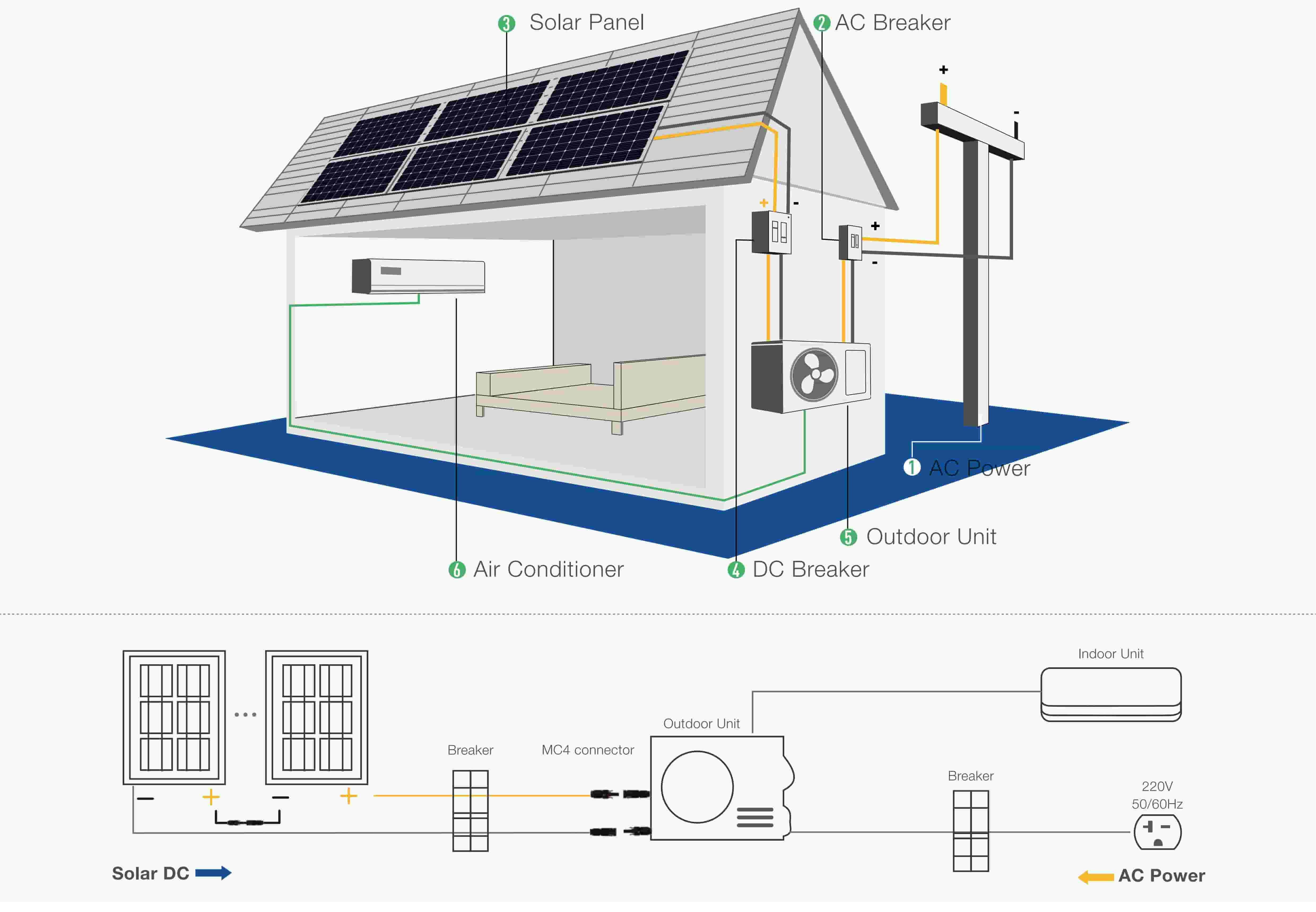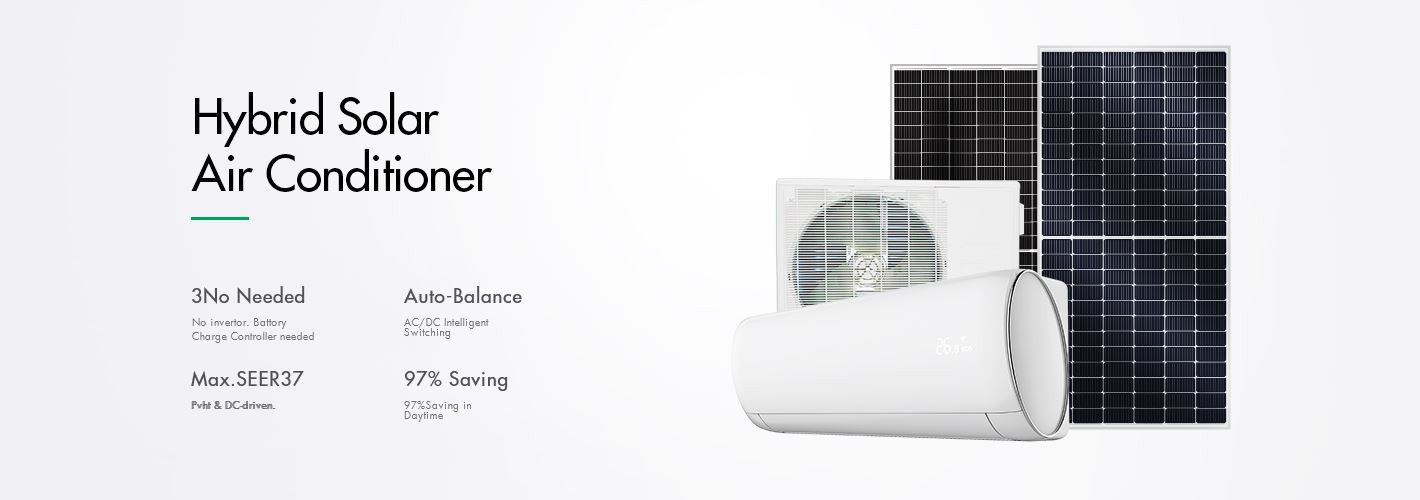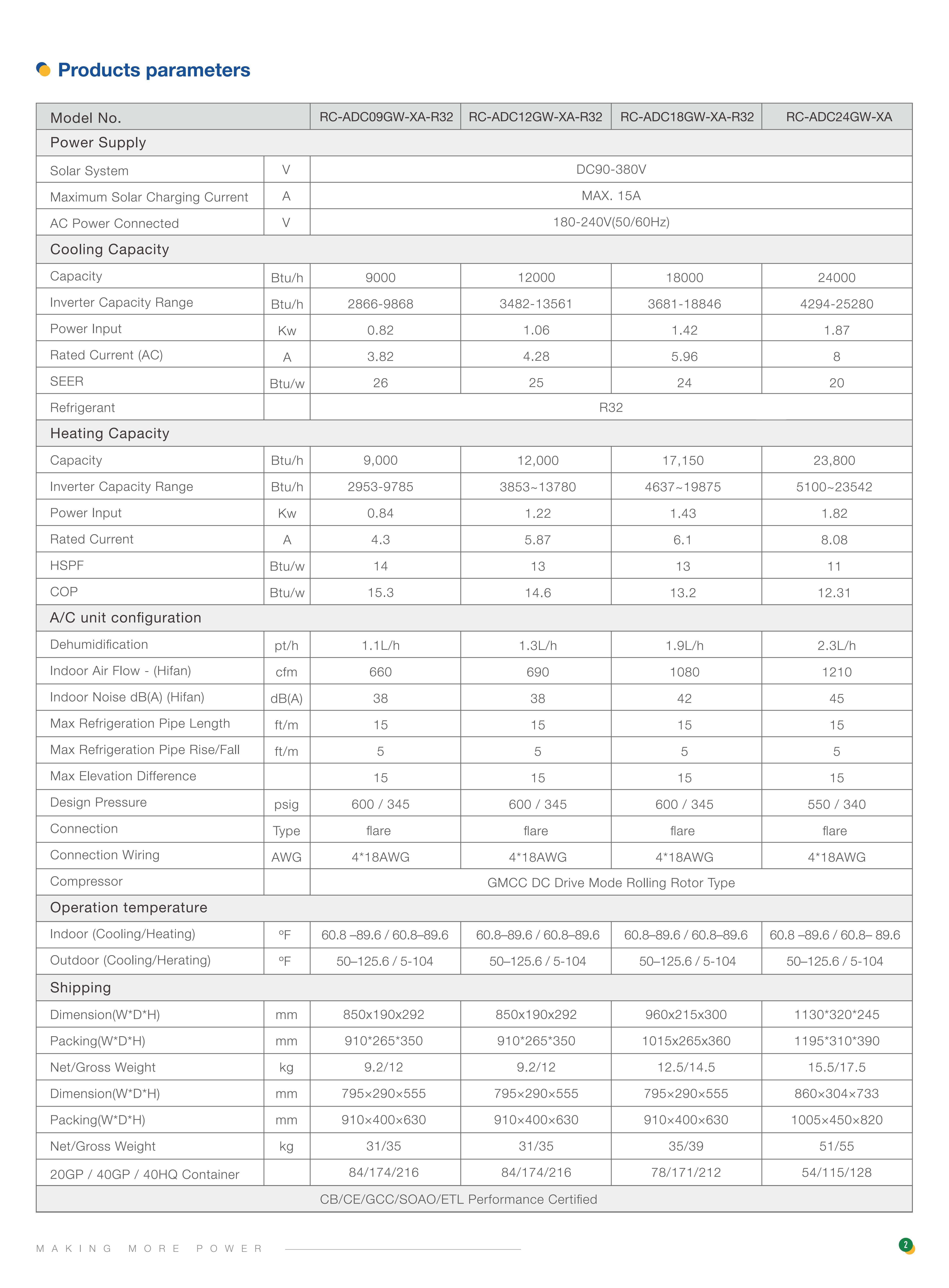Installing a solar-powered air conditioner can be a great to reduce your energy consumption and lower your carbon footprint.
Solar panel voltage:
DC90-380VMaximum Solar Charging Current:
15AAC Power Connected:
180-240V(50/60Hz)Refrigerant:
R32Compressor:
GMCC DC Drive Mode Rolling Rotor TypeConnection:
Flare
Here are the general steps to install a solar air conditioner:
Determine your energy needs: Assess the size and cooling capacity required for your space. This will help you choose the appropriate solar air conditioner model.
Choose the right solar panels: Select high-efficiency solar panels that can generate enough electricity to power your air conditioner. Consider factors such as the available roof space, sunlight exposure, and local climate conditions.
Install the solar panels: Mount the solar panels on a sturdy and unobstructed area, typically on the roof or an open ground space. Ensure that the panels are facing the sun optimally to maximize energy generation. Hiring a professional solar installer is recommended for safety and proper positioning.
Install the inverter and batteries: The solar panels generate direct current (DC), which needs to be converted into alternating current (AC) using an inverter. The inverter is connected to a set of batteries to store excess energy produced during peak periods of sunlight.
Connect the solar system to the air conditioner: Depending on the type of solar air conditioner you choose, you may need to connect it directly to the AC output of the inverter or through a dedicated electrical panel. Follow the manufacturer's instructions for proper wiring and connection.
Install the air conditioner components: Install the indoor unit(s) and outdoor condenser unit(s) of the air conditioner following the manufacturer's guidelines. Ensure proper ventilation and clearance for the outdoor unit to facilitate efficient operation.
Test and commission the system: Once the installation is complete, test the solar air conditioner to ensure it's functioning correctly. Check if the solar panels are generating enough power to run the air conditioner effectively.
Monitor and maintain the system: Regularly monitor the performance of your solar air conditioner and clean the solar panels to maintain optimum efficiency. If necessary, perform any recommended maintenance tasks as outlined in the manufacturer's instructions.
Remember, installing a solar air conditioner may require professional expertise, particularly for electrical connections and system integration. Consulting with a qualified solar installer is highly recommended to ensure proper installation and adherence to safety guidelines.

Sun-powered air conditioners, also known as solar air conditioners, utilize solar energy to power their cooling systems. The basic working principle of a sun-powered air conditioner is as follows:
Solar Panels: Solar panels or photovoltaic (PV) modules are installed to capture sunlight and convert it into electricity. These panels consist of multiple solar cells made of semiconducting materials, usually silicon.
Inverter: The electricity generated by solar panels is in the form of direct current (DC), but most air conditioners operate on alternating current (AC). An inverter is used to convert the DC power into AC power, making it compatible with the air conditioning system.
Compressor and Refrigerant: The AC power is supplied to the air conditioner's compressor, which compresses the refrigerant gas, raising its temperature and pressure.
Condenser: The high-temperature, high-pressure refrigerant flows into the condenser, where it releases heat to the surrounding environment. This causes the refrigerant to change from a gas to a high-pressure liquid.
Expansion Valve: The high-pressure liquid refrigerant then passes through the expansion valve, which regulates its flow and reduces its pressure. This process causes the refrigerant to evaporate and cool down.
Evaporator: The cool refrigerant enters the evaporator, which is located inside the indoor unit of the air conditioner. As warm air from the room passes over the evaporator coil, the refrigerant absorbs heat from the air, cooling it down and lowering the room temperature.
Air Distribution: The cooled air is then distributed throughout the room using fans or blowers, providing comfortable conditions.
Cycle Continuation: The refrigerant, now in a low-pressure gaseous state, returns to the compressor to repeat the cooling cycle.
In a solar-powered air conditioner, the solar panels provide the electricity needed to run the compressor and associated components, reducing reliance on grid power. The system may be connected to the electrical grid for backup power during periods of low sunlight or high cooling demand. Additionally, advanced solar air conditioning systems may incorporate energy storage solutions, such as batteries, to store excess solar energy for later use.
It's worth noting that solar-powered air conditioning systems come in various configurations and designs, and the specific details of their operation can vary. It is advisable to consult with a professional or the manufacturer to determine the suitability and installation requirements for your specific needs.

The warranty for a solar air conditioner can vary depending the manufacturer and the specific product. Generally, solar air conditioner warranties cover defects in materials and workmanship for a certain period of time. These warranties typically range from 1 year to 10 years or more. It's important to review the warranty terms and conditions provided by the manufacturer to understand what is covered and for how long.
In addition to the overall warranty, certain components such as the solar panels, inverter, compressor, and other parts may have separate warranties with different coverage periods. For example, the solar panels may have a warranty of 25 years or more as they are typically designed to have a long lifespan.
It's recommended to carefully read the warranty documentation provided by the manufacturer, and if you have any specific concerns or questions, you can reach out to the manufacturer or the authorized dealer for clarification.
FAQs:
Q1: Do you support OEM/ODM?
A:Definitely, OEM&ODM service is supported with a certain quantity,including customize logo,package and label;
Q2: What's the production time?
A: The production time is normally 15 working days. but we will always prepare some stocks for popular models.
Q3: Can you provide DDP service?
A:Yes, if you are a personal customer and don't want to deal with the customs, we can provide DDP service to your address.
Q4: What about the warranty and how to claim?
A: Warranty period are 5 years since you receive the product, our professional after-sales team will deal with all warranty issues.